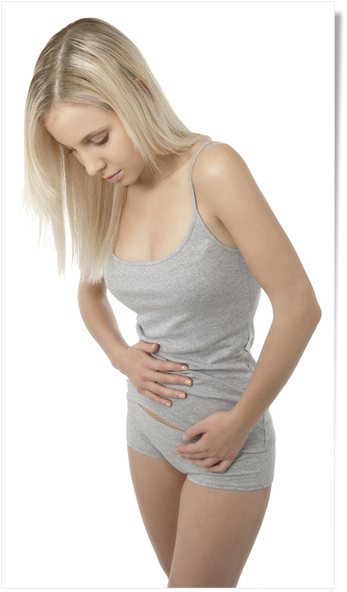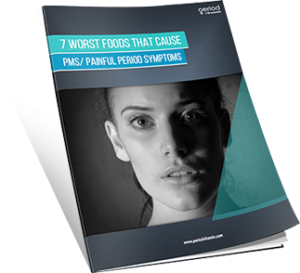Many women suffer from nausea during their period and some actually have vomiting as well as constipation or diarrhea. What causes this discomfort for so many women every month and what can be done about it, are there other symptoms that always or almost always accompany this nausea for most women?
What causes this nausea and is it normal?
 Why are so many women susceptible to nausea and vomiting during the menstrual cycle? When does this normally occur?
Why are so many women susceptible to nausea and vomiting during the menstrual cycle? When does this normally occur?
The menstrual cycle is different for every woman so don’t expect this information to be exactly everyone’s experience. However a large number of women will experience nausea with a percentage of those women actually throwing up during their menstrual cycle and an upset stomach after eating being fairly common.
So why does this happen?
Dysmenorrhea seems to be a condition where nausea and vomiting is accompanied by headaches, cramps, and abdominal pain. It is thought that the production of prostaglandins during the menstrual cycle can cause the walls of the uterus to contract and causing both cramping and nausea.
There could be a more serious reason for this nausea – that being a condition known as endometriosis. This occurs when the cells (endometrium) that make up the lining of the uterus grow outside of the uterus. These cells grow in large number and line both the abdominal and uterine cavities. During the woman’s menstrual cycle these cells are influenced by the hormone production and imbalance. Endometriosis can cause nausea, bloating, diarrhea, rectal pain, and abdominal cramping.
Perhaps the most common symptom of endometriosis is not the nausea but debilitating pain.
Endometriosis can be so severe that it can require surgery and perhaps a full hysterectomy. However endometriosis is not the primary cause of nausea during periods. A Vitamin B deficiency and/or sugar imbalance can also be the cause of nausea before, during or after a woman’s menstrual cycle.
Menstrual Cycle Stages:
Premenstrual Stage – two to three weeks prior to period and nausea can be strong at this point.
Stage 1 – Follicular stage has high estrogen levels.
Stage 2 – Luteal stage includes ovulating and has a strong nausea component.
Period – This is when a woman sheds the uterine lining along with blood and water. Nausea has normally stopped by this time.
Post Menstrual Stage – After the period is over and there is very little nausea during this time.
Menopausal Nausea – returns due to hormone fluctuations and increases in estrogen.
Pregnancy – Especially during the first trimester nausea is fairly common.
Other Symptoms:
 The cramping that usually accompanies the menstrual period is the primary cause of this upset stomach and it can occur before, during or after a woman’s period. However, this nausea could also be caused by excess stomach acid that comes from the changes and imbalance in hormones during the menstrual cycle. There are two other possible causes of nausea in the menstrual cycle include migraine headaches and premenstrual syndrome.
The cramping that usually accompanies the menstrual period is the primary cause of this upset stomach and it can occur before, during or after a woman’s period. However, this nausea could also be caused by excess stomach acid that comes from the changes and imbalance in hormones during the menstrual cycle. There are two other possible causes of nausea in the menstrual cycle include migraine headaches and premenstrual syndrome.
PMS (premenstrual syndrome) happens before a woman’s period and includes all the symptoms we have previously mentioned such as sore breasts, headaches, sugar cravings, bloating, stress, anxiety, acne, back and thigh pain, diarrhea, fatigue and constipation.
PMS is due to the production of estrogen and progesterone in the early stages of the menstrual cycle prior to period bleeding. Nausea is a common symptom of PMS. It is also very common for women to feel nausea at the point in their menstrual cycle when they ovulate.
The other cause is migraine headaches that can affect some women prior to their period following ovulation. Nausea typically accompanies migraines regardless of the cause of the headache. In this case the headaches are caused by the hormonal imbalance and they can be completely debilitating along with the nausea.
Migraine headaches during the menstrual cycle are considered an “episodic neurological disorder”. In addition to the debilitating head pain, the woman also suffers any one of many different symptoms including nausea, dizziness, sensitivity to light and sound, cognitive difficulties, and a numbness or tingling.
It is fairly common for young girls to experience migraines and nausea when they begin to have their period for the first time, but severe migraines can continue throughout the woman’s life.
As a woman ages, she may experience various symptoms of the hormone induced migraine without the headache. She might just have light and noise sensitivity without the headache or might just have severe nausea without the headache itself. Any of the aforementioned symptoms might occur without the actual headache. Quite often the best treatment for nausea and other symptoms from migraines is to lie down in a darkened room or with a mask over your eyes.
Pregnant women often suffer from migraines and nausea as well. Usually this is in the first trimester and is attributed to the same reproductive hormones that cause nausea in the menstrual cycle. There might also be sensitivity to smells as well.
Remedies
So now we know the variety of reasons that a woman might have nausea during her period. So how does a woman know what to do about it? What are the treatments or remedies? How can this nausea be relieved? There are several different answers to these questions in respect to getting relief from this nausea. Depending in the cause of the nausea there would be different ways to reduce or get rid of it.
If the nausea is caused by pain then alleviating the pain should cure the nausea. Some simple ways to deal with the pain and thus stop the nausea would include over the counter medications such as Midol, Pamprin, NSAIDs (Non- Steroidal Anti- Inflammatory Drugs) or Tylenol. In the case of endometriosis or severe pain a prescription analgesic may be necessary.
Some of the other remedies for nausea regardless of the cause include:
Ginger – Whether made into a tea or ground up or even just sucked as a crystal, ginger is well known for both preventing and relieving nausea regardless of its cause. Ginger is one of the best remedies for menstrual cycle nausea. It is also the one herb that has been researched the most, has had the most clinical trials completed of any herbs and been deemed the most effective herb for menstrual cycle nausea and vomiting.
Antacids – These can relieve nausea if it is caused by excess acid in the stomach which happens at times during the menstrual cycle.
Mint tea – Pour a cup of boiling water over a handful of mint leaves to create mint tea. Steep for at least 5 minutes then add lemon and/or honey. You can also make iced mint tea. The menthol in the mint is the active ingredient that cures nausea.
Warm milk with ground cinnamon is an excellent treatment for nausea regardless of its cause.
This is also true with lemon and/or lime mixed with a glass of water. It will cure vomiting and curb nausea.
Cayenne – Capsicum frutescence relieves nausea, indigestion and vomiting regardless of the reason.
Cloves – Eugenia caryophyllata also relieves nausea and stops you from vomiting. It also alleviates bloat which can cause nausea and just a few drops work quickly to bring relief from nausea and to prevent vomiting.
Curcumin – Curcumin longa works to alleviate nausea, provide stomach protection and reduce acid.
Patchouli – Pogostemon cablin this fragrant Indian herb, works to stop stomach spasms and thereby prevent nausea and vomiting.
Galangal – Alpinia officinarum is a ginger-like herb that acts as a cure for motion sickness, sea sickness, vomiting and nausea.
Marshmallow – Althea officinalis can prevent nausea during periods and also prevent indigestion. Sooths the stomach lining.
 Raspberry Leaf – Rubus idaeus is an astringent that prevents vomiting, diarrhea and nausea. It also helps to balance the hormones during the menstrual cycle.
Raspberry Leaf – Rubus idaeus is an astringent that prevents vomiting, diarrhea and nausea. It also helps to balance the hormones during the menstrual cycle.
Chamomile Tea is an excellent remedy for menstrual cycle nausea.
There are so many things that can cause nausea, vomiting or indigestion that many different various remedies and treatments are available. Of course as previously mentioned the easiest of these is birth control pills. You could also use a hot water bottle or a heating pad on your stomach.
So in conclusion, nausea during period is a fairly common situation. The hormones that change and fluctuate around ovulation are the primary culprits in this situation. As mentioned you have a surge in estrogen followed by a surge in progesterone and this causes nausea.
Extra acid can be formed in a woman’s stomach at this time as well. There are also medications that women might be taking that will cause menstrual cycle nausea as well. These include anti-inflammatory drugs, fertility treatments and mega doses of Vitamin C. If you do suffer from menstrual cycle nausea be sure to try one or more of the many tips, ideas, treatments and remedies we have shared.

 Ginger – Whether made into a tea or ground up or even just sucked as a crystal, ginger is well known for both preventing and relieving nausea regardless of its cause. Ginger is one of the best remedies for menstrual cycle nausea. It is also the one herb that has been researched the most, has had the most clinical trials completed of any herbs and been deemed the most effective herb for menstrual cycle nausea and vomiting.
Ginger – Whether made into a tea or ground up or even just sucked as a crystal, ginger is well known for both preventing and relieving nausea regardless of its cause. Ginger is one of the best remedies for menstrual cycle nausea. It is also the one herb that has been researched the most, has had the most clinical trials completed of any herbs and been deemed the most effective herb for menstrual cycle nausea and vomiting.
